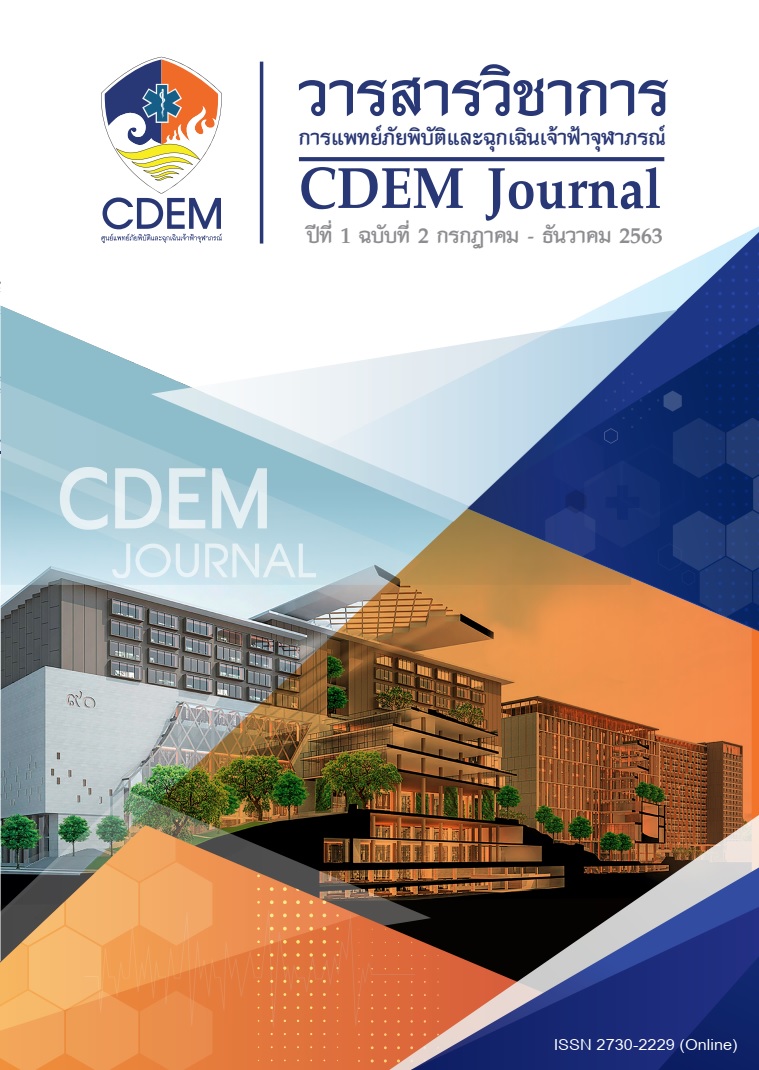Factors Associated Prehospital Trauma Patients Transferred By EMS (FR/BLS) Without Spinal Motion Restriction(SMR)
Keywords:
Spinal motion restriction, Spinal motion restriction protocol, EMS personnel, Prehospital BLSAbstract
Abstract
Background: Spinal motion restriction (SMR) plays a major role in spinal protection toprevent secondary injury during prehospital transportation
Objectives: To determine the factors associated with improper spinal motion restriction in trauma patients who transferred by emergency medical services (EMR/EMT).
Methods A prospective analytical study from September to November 2019.Adult trauma patients who were transferred by EMS (EMR/EMT) to the ED of Hatyai hospital, Songkla province was studied. Assessment of factors with questionnaire to EMS personnel by triage nurse or emergency resident and medicalrecord.
Results: Of 428 patients were transferred to the ED by local basic EMS. Only 25% were received SMR properly and 70% were injured by traffic accidents. Patients were triaged into ESI level 3-5 85.5% and these groups of patient significantly weren’t received the SMR properly compare to those in level 1-2 (OR 3.75 95% CI 2.15, 6.56 P<0.001)
Conclusions: The most three causes of improper SMR were patient’s factors, EMS’s protocol and personnel efficiently and mechanisms of injury.
Keywords Spinal motion restriction, Spinal motion restriction protocol, EMS personnel, Prehospital BLS
References
1. Stroh G, Braude D. Can an out-of-hospital cervical spine clearance protocol identify all patients with injuries? An argument for selective immobilization. Ann Emergency Med. 2001 Jun; 37(6):609–15.
2. Meldon SW, Brant TA, Cydulka RK, Collins TE, Shade BR. Out-of-hospital cervical spine clearance: agreement between emergency medical technicians and emergency physicians. J Trauma. 1998 Dec; 45(6):1058–61. 1.
3. Kwan I, Bunn F. Effects of prehospital spinal immobilization: a systematic review of randomized trials on healthy subjects. Prehospital Disaster Med. 2005 Feb; 20(1):47–53.
4. Horodyski M, DiPaola CP, Conrad BP, Rechtine GR. Cervical collars are insufficient for immobilizing an unstable cervical spine injury. J Emergency Med. 2011 Nov; 41(5):513–9.
5. Domeier RM, Swor RA, Evans RW, et al. Multi-center prospective validation of prehospital clinical spinal clearance criteria. J Trauma. 2002;53(4):744-750.
6. Domeier RM, Frederiksen SM, Welch K. Prospective performance assessment of an out-of-hospital protocol for selective spine immobilization using clinical spine clearance criteria. Ann Emergency Med. 2005 Aug;46(2):123–31.
7. Vaillancourt C, Charette M, Kasaboski A, Maloney J, Wells GA, Stiell IG. Evaluation of the safety of C-spine clearance by paramedics: design and methodology. BMC Emergency Med. 2011 Feb 1;11:1.
8. Theodore N, Hadley MN, Aarabi B, Dhall SS, Gelb DE, Hurlbert RJ, et al. Prehospital cervical spinal immobilization after trauma. Neurosurgery. 2013 Mar;72 Supply 2:22–34.
9. Sundstrøm T, Asbjørnsen H, Habiba S, Sunde GA, Wester K. Prehospital use of cervical collars in trauma patients: a critical review. J Neurotrauma. 2014 Mar 15;31(6):531–40.
10. Bernard, R. (2000). Fundamentals of biostatistics (5th ed.). Duxbery: Thomson learning, 384-385.
11. Fleiss, J. L., Levin, B., Paik, M. C. (2003). Statistical methods for rates and proportions (3rd ed.). John Wiley&Sons
12. Ngamjarus C., Chongsuvivatwong V. (2014). n4Studies: Sample size and power calculations for iOS. The Royal Golden Jubilee Ph.D. Program - The Thailand Research Fund&Prince of Songkhla University
13. Connell RA, Graham CA, Munro PT. Is spinal immobilization necessary for all patients sustaining isolated penetrating trauma? Injury. December 2003;34(12):912–4.
14. Galvagno SM, Nahmias JT, Young DA. Advanced Trauma Life Support® Update 2019: Management and Applications for Adults and Special Populations. Anesthesiology Clinic. 2019 Mar;37(1):13–32.
15. The National Association of Emergency Medical Technicians. PHTLS: prehospital trauma life support/ National Association of Emergency Medical Technicians. 9th edition. Vol. 2019. United state of America;
16. สื่อการสอนของเจ้าหน้าที่ระบบบริการการแพทย์ฉุกเฉินระดับพื้นฐาน โดยสถาบันการแพทย์ฉุกเฉินแห่งประเทศไทย (2019)
Downloads
Published
Issue
Section
License
บทความที่ได้รับการตีพิมพ์เป็นลิขสิทธิ์ของวารสารวิชาการ การแพทย์ภัยพิบัติและฉุกเฉินเจ้าฟ้าจุฬาภรณ์
ข้อความที่ปรากฏในบทความแต่ละเรื่องในวารสารวิชาการเล่มนี้เป็นความคิดเห็นส่วนตัวของผู้เขียนแต่ละท่านไม่เกี่ยวข้องกับราชวิทยาลัยจุฬาภรณ์ และคณาจารย์ท่านอื่นๆในราชวิทยาลัยฯ แต่อย่างใด ความรับผิดชอบองค์ประกอบทั้งหมดของบทความแต่ละเรื่องเป็นของผู้เขียนแต่ละท่าน หากมีความผิดพลาดใดๆ ผู้เขียนแต่ละท่านจะรับผิดชอบบทความของตนเองแต่ผู้เดียว



